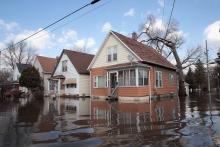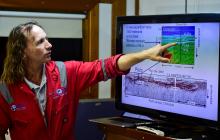
Cultural anthropologist David Casagrande describes the landscape from a recent trip to the eastern shore of Maryland. Front yards have become salt marshes, with fiddler crab holes. Some use a “salt water” car on particularly bad days, and at times, a school bus cannot get through the water to its stops
According to the Maryland Eastern Shore Land Conservancy, the sea level is expected to rise by at least 1.4 feet by 2050, and possibly more than 5 feet by 2100. Yet, with many living in homes that have been in their families for several generations, there is little talk of moving.
Casagrande, chair of the sociology and anthropology department, is examining how residents in flood-prone communities perceive the problem, and the solution. Interviews with stakeholders in the Midwest and in Maryland, show that while risk is perceived differently by a range of individuals, a change of heart and minds may be needed, because of increasing flooding.
The policy of managed retreat (he defines it as helping people move away from increasing flood risk), while effective, is controversial because residents don’t buy into it, and admitting a problem could endanger the local economy. To avoid a community diaspora, relocating entire communities may be a better option in some cases. A survey of 648 Midwest households found that while 77 percent of those surveyed support post-flood buyouts, only 54 percent support pre-flood buyouts.
In the U.S., the Midwest saw a managed retreat success in Valmeyer, Ill., where Federal Emergency Management Agency (FEMA) buyouts, Housing and Urban Development (HUD) grants and private investing following a 1993 flood were used to build a new town on higher ground. In the Midwest, the surrounding terrain is such that a new community can be laid out on farmland. Although it looks different from the old town, “they tell me, every time the river floods, they thank god the town moved,” Casagrande says.
In Louisiana, a managed retreat program is being carried out on Isle de Jean Charles, a narrow ridge in Terrebonne Parish, thanks to a $48 million HUD grant in 2016. It is the first example of a comprehensive state and federal funding package to relocate an entire town because of rising seas.
Casagrande notes that following a post-earthquake tsunami in Tohoku, Japan in 2011, some 145,000 homes were relocated to new villages. “It’s an example of what you can do,” said Casagrande, the co-author on a research article on the Japanese managed retreat published in Natural Hazards in April 2019.
But such successful managed retreats are few, and Casagrande and his teams are learning some of the reasons why, after conducting 113 interviews in the Midwest and 67 in Maryland with residents, business-owners and government officials.
Time delay, fragmented funding, and uncertainty are impediments to successful relocation, he found, and visionary local leadership is crucial. Additionally, homeowners share a “sense of place” and “the cultural integrity and history of the community.”
Most people have a “structural bias” --the idea that structures like levees or seawalls are the best answer. He suggests good leadership is necessary to convey to residents how a move can solve other economic problems and invigorate the local economy.
Another impediment is time, or lack of it. “We have to make the process faster,” he says. And money.
“There is no dedicated pot of federal money with which to do a managed retreat.”
The Midwest research began in 2008 when unusually bad flooding hit the Mississippi River. Casagrande, then an associate professor at Western Illinois University, and a colleague, were asked by the Illinois Governor’s office to report on recovery experiences, and they obtained two grants from the National Science Foundation.
A Lehigh Faculty Research Grant allows him to study managed retreat on Maryland’s Eastern Shore, with Washington College. “What got me into this was the historical impact map for Dorchester County (via Maryland Department of Planning and Maryland Historic Trust). In 30 years, 60 percent of the county will be permanently inundated, displacing 20,000-30,000 people. The homeowners are proud of being resilient, independent and hardworking, as they describe themselves. “They don’t want to be abandoned,” says Casagrande. “But many deny a rising sea level problem and say the problem is erosion.”
Currently, Casagrande and a team from Lehigh's psychology department are working with the College of Engineering’s Institute for Cyber Physical Infrastructure and Energy (IC-PIE) to better assess community resilience and study how residents responded to Hurricane Florence, which occurred in 2018. A Lehigh Collaborative Research Opportunity (CORE) grant funds this research.






























